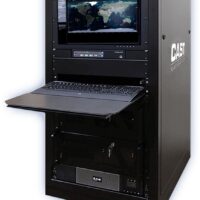GPS simulation is a testing method that allows developers of military GPS receivers and navigation systems, as well as GPS-aided INS (inertial navigation systems), to test how their products will respond to different conditions and stimuli without the need for “live sky” testing. In addition to GPS, other GNSS constellations may be simulated, including Galileo, BeiDou, GLONASS, SBAS and QZSS.
The navigation systems tested via simulation may be used to provide critical PNT (position, navigation and timing) capabilities for military aircraft and helicopters, naval vessels, armored vehicles and other land platforms, unmanned systems and more.
Military GNSS & GPS Simulators
GPS simulators allow testing to be undertaken that can be quicker and less costly than deploying the system under test on an actual aircraft or vehicle. The testing is also much more repeatable and consistent, as test conditions can be specified precisely and will be the same every time, without the effects of randomly varying factors such as weather, atmospheric conditions, noise, and obstacles.
Military GPS and GNSS simulators may be single-constellation or multi-constellation, and for each constellation may offer single- or multi-frequency testing. The number of channels may also vary. Unlike civilian GNSS simulation systems, military testing equipment may also allow simulation of restricted signals such as GPS M-code.
Navigation Simulation
Navigation simulation allows specific trajectories to be defined that mimics specific vehicles and aircraft platforms, including their unique dynamics. Data that has been captured from actual movements can also be fed in.
Different satellite conditions can be tested, including number of visible satellites in the constellation, position in the sky, and atmospheric conditions. A wide range of system parameters can be tested, including time to first fix, reacquisition time, acquisition and tracking sensitivity, and response to multipath.
Simulators can also be used to test a receiver or system’s response to jamming and spoofing.















